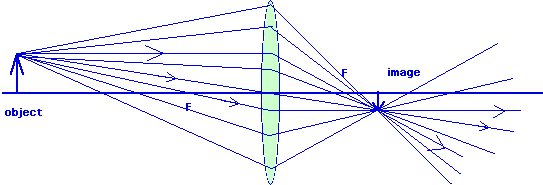

Image Formation by Lenses
As with mirrors, we will concentrate on three principal rays in our understanding of image formation.



The location of the image is given by the image equation, also called the thin lens equation,
Real images are like the one in the diagram above.
The light actually passes through the image.The image will be projected on a screen placed at the image position.
The image distance di is positive for a real image.
Sign conventions:
Start with a real object to the left of the lens, with light going from left to right as shown in our figures above.do > 0 for a real object.
f > 0 for a converging lens
f < 0 for a diverging lens
di > 0 for an image on the right side of the lens (this will be a real image)
di < 0 for an image on the left side of the lens (this will be a virtual image)

Virtual images are like the ones in the diagram above.
The light does not pass through the image.The image can not be projected on a screen placed at the image position.
The image distance di is negative for a virtual image.
Magnification:

Some examples:
• do > 2 f• real, inverted, smaller
As the object moves closer to the focal point, the image size INCREASES.
A virtual image is formed for an object inside the focal point.
A DIVERGING lens forms a virtual image from a real object.
(c) Doug Davis, 2002; all rights reserved

Return to Ch 24, Mirrors and Lenses